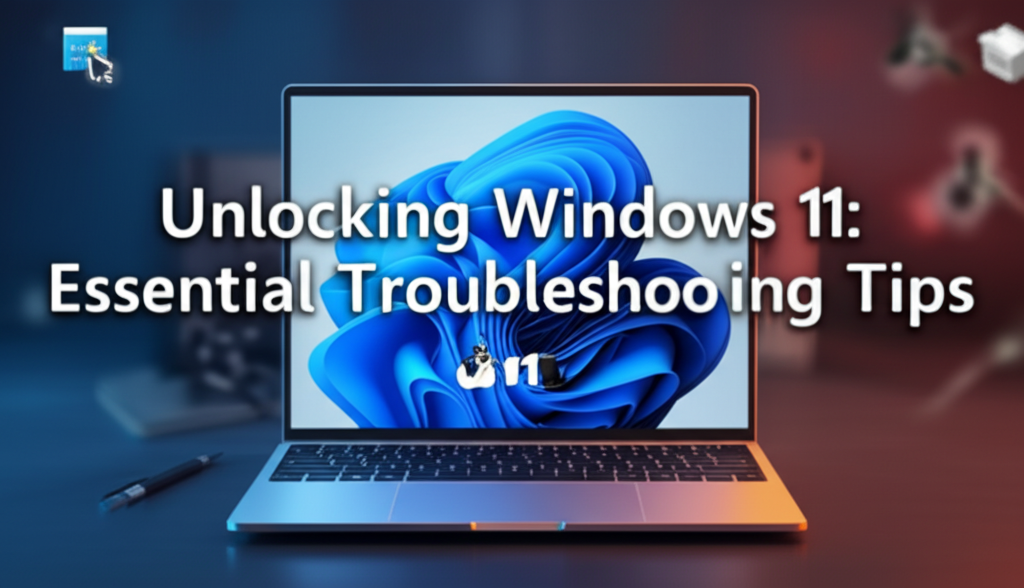Introduction
Windows 11 has revolutionized the user experience with its sleek design, improved performance, and seamless integration of features. However, every operating system comes with its share of challenges. Whether you are a casual user, a student, or a professional, knowing how to troubleshoot common Windows issues can enhance your productivity and make your experience with the OS much smoother.
In this comprehensive guide, we’ll take you through step-by-step troubleshooting tips for unlocking Windows 11. We’ll cover everything from basic issues to advanced tweaks, making sure you have all the information you need at your fingertips. Let’s get started!
Understanding Common Windows 11 Problems
Before diving into troubleshooting, it’s important to understand some common issues that might arise when using Windows 11:
- Slow Performance: Many users experience lagging when applications or processes run slowly.
- Boot Issues: Sometimes, your PC might not boot up properly.
- Connectivity Problems: Wi-Fi or Bluetooth issues can prevent you from connecting to the internet or other devices.
- Application Crashes: Some apps may frequently stop responding or crash altogether.
Why This Matters
Getting familiar with these issues and knowing how to solve them can save you time and frustration. Instead of needing to call for help or spend hours searching for solutions online, you can quickly resolve problems and get back to what’s important—whether that’s work, studying, or digital entertainment.
Step-by-Step Troubleshooting Instructions
1. Slow Performance
Step 1: Check for Resource-Hogging Processes
- Open Task Manager: Right-click on the taskbar and select Task Manager.
- View Performance: Click on the ‘Processes’ tab to see a list of running applications and their resource usage.
- End High Resource Processes: If you notice any processes that are consuming a lot of CPU or memory (like web browsers or games), right-click on them and select End Task.
Tip: Regularly check your startup programs, as many applications launch automatically and can slow down your system. To manage startup programs, go to the ‘Startup’ tab in Task Manager.
Step 2: Update Your Drivers
- Open Device Manager: Search for Device Manager in the Start menu.
- Check for Updates: Expand categories such as Display Adapters and Network Adapters, right-click on any device, and choose Update Driver.
2. Boot Issues
Step 1: Restart Your PC
It may seem basic, but many boot issues can be solved by a simple restart.
Step 2: Use Advanced Startup Options
- Access Settings: Click on the Start Menu, then Settings.
- Navigate to Recovery: Go to System > Recovery and under Advanced Startup, click Restart Now.
From there, you can choose to troubleshoot, use system restore points, or boot into safe mode.
Step 3: Use Startup Repair
- After accessing Advanced Startup, select Troubleshoot > Advanced Options > Startup Repair. Windows will attempt to automatically fix any boot files or issues.
3. Connectivity Problems
Step 1: Troubleshoot Network
- Open Settings: Navigate to Settings > Network & Internet.
- Run the Troubleshooter: Select Status and then click on Network Troubleshooter to automatically diagnose and fix network issues.
Step 2: Reset Network Settings
If the troubleshooter doesn’t work:
- Open Advanced Network Settings: In Network & Internet, go to Advanced Network Settings > Network Reset.
- Follow Prompts: Click Reset now and follow the instructions to remove and reinstall network adapters.
4. Application Crashes
Step 1: Update Applications
Make sure all your applications are up-to-date, as software updates often include bug fixes.
- Update from the Microsoft Store: Open the Microsoft Store, click on the Library icon, and select Get Updates.
Step 2: Check for System Updates
Sometimes the issue may be resolved through the latest Windows updates.
- Go to Settings: Navigate to Settings > Windows Update and click Check for updates.
Alternative Software Recommendations
If you find certain built-in software lacking, consider these alternatives:
- File Management: While Windows Explorer is powerful, check out FreeCommander for an alternative with dual-pane support.
- Image Editing: Replace the built-in Paint with GIMP, a free and highly functional editing tool.
- PDF Reading: If Edge isn’t working well for you, try Foxit Reader for better performance.
Common Errors and Quick Fixes
As we navigate Windows 11, you may encounter several common errors. Here are quick fixes for some of them:
Error: "The Specified Device is Not Responding"
- Quick Fix: Unplug and replug the device. Check for driver updates as mentioned above.
Error: "Windows Update Failed"
- Quick Fix: Run the Windows Update troubleshooter found in Settings > Update & Security > Troubleshoot.
Error: "Application Not Responding"
- Quick Fix: Always try to end the task from Task Manager. If the issue persists, reinstall the application.
Advanced Tweaks and Shortcuts for Power Users
For those looking to boost their experience even further, these advanced tips can help:
1. Virtual Desktops
Organize your workspaces using virtual desktops:
- Create New Desktop: Press Windows + Ctrl + D to create a new virtual desktop.
- Switch Desktops: Use Windows + Ctrl + Left/Right Arrow to navigate between them.
2. Keyboard Shortcuts
Familiarizing yourself with keyboard shortcuts can improve efficiency:
- Windows + E: Open File Explorer.
- Windows + L: Lock your screen.
- Windows + I: Open Settings.
3. Task Manager Startup Management
- Open Task Manager, and under the Startup tab, disable any programs you don’t need to start up with Windows.
Final Summary Checklist
Here’s a concise checklist for ready reference:
-
Slow Performance:
- Check for resource-hogging processes.
- Update device drivers.
-
Boot Issues:
- Restart your PC.
- Access Advanced Startup for repairs.
-
Connectivity Problems:
- Use the built-in Network Troubleshooter.
- Reset network settings if needed.
-
Application Crashes:
- Ensure all applications are updated.
- Check for Windows updates.
- Advanced Tweaks:
- Utilize virtual desktops.
- Memorize essential keyboard shortcuts.
- Manage startup applications via Task Manager.
With these troubleshooting techniques and tips, you should be well-equipped to handle common Windows 11 challenges. Empower yourself to resolve issues quickly and enjoy a more productive computing experience!

